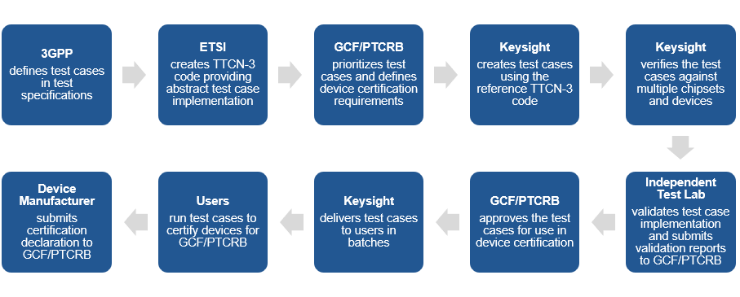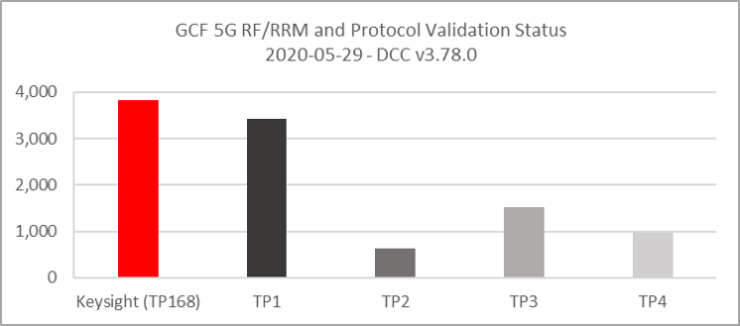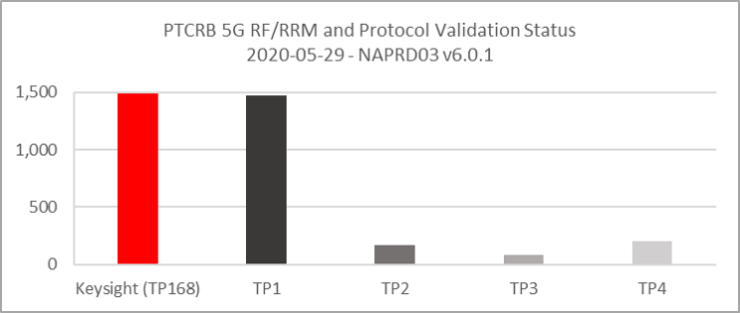
5G Testing: Conformance Testing Process and Coverage Matter
The 3rd Generation Partnership Project (3GPP) sets the standards for mobile cellular communications, the Global Certification Forum (GCF) and the PCS Type Certification Review Board (PTCRB) mandate 3GPP test cases for device certification, and government agencies around the world issue regulations to ensure public safety. With the commercial development and deployment of 5G technology accelerating, early and continuous access to the latest 3GPP protocol, radio frequency (RF), and radio resource management (RRM) conformance test specifications is essential to accelerate 5G New Radio (NR) device certification.
A test case is an executable script created to verify a test case defined in 3GPP technical specifications. 3GPP-related test cases are usually named after the section of the specification on which they are based. 3GPP conformance specifications cover three main classes of test cases for ensuring that new 5G devices work correctly with the radio access network (RAN):
- protocol
- RF
- RRM
The GCF and PTCRB mandate a selection of 3GPP test cases that chipset and device manufacturers must comply with to achieve certification. Once they select the test cases, test vendors implement the corresponding test specifications in their conformance test solutions. At Keysight, we collaborate with a range of chipset and device vendors to confirm that the 3GPP test specifications correctly verify the underlying 5G functionality and our interpretation. An independent, accredited validation organization then validates the implementation of each test case against the 3GPP specifications and GCF/PTCRB requirements. If successful, the validation organization submits the test results to GCF and PTCRB, requesting approval for the test cases to be used for formal device certification testing.

Figure 1. GCF/PTCRB protocol certification process at Keysight
Protocol conformance testing requires access to the latest 3GPP-defined 5G, Long Term Evolution (LTE), and cellular vehicle-to-everything (C-V2X) test cases. You also need frequency range 1 (FR1, sub-6 GHz) and frequency range 2 (FR2, millimeter-wave, or mmWave) support for both 5G non-standalone (NSA) and standalone (SA) modes. Integration with an over-the-air (OTA) chamber is essential to cover an extended range of FR2 test cases.
RF performance testing of 5G devices against the 3GPP-defined conformance test specifications also spans FR1 and FR2 and requires support for C-V2X communication test cases. Testing 5G NR RF characteristics includes in-band test cases and out-of-band (OOB) measurements such as spurious emissions and blocking. In-band test cases focus on the radio’s performance as a transmitter and receiver. OOB measurements help determine how the device’s radio impacts other devices operating in the same or adjacent bands. These measurements also assess resistance to interference from nearby radio devices.
Fully characterizing the RF performance of 5G devices also requires RRM and performance testing. RRM helps confirm that the device can keep a robust and reliable connection to the network in stationary and mobility scenarios, with handovers between cells using the same or different radio access technologies (RATs). Performance testing checks that the device can successfully demodulate downlink signals under ideal or impaired radio conditions, with special tests defined for channel state information (CSI) reporting.
Test cases can either be validated or unvalidated. Validated test cases refer to the test cases validated at relevant certification organizations including the GCF, PTCRB, and regulatory bodies such as the Telecom Engineering Center (TELEC), Korea Communications Commission (KCC), and the Radio Equipment Directive (RED). Unvalidated test cases enable you to customize the baseline test methodologies and test limits from 3GPP. You can test the device beyond industry requirements, explore its performance limits, and compare its performance against competitive devices to enhance end-user experience.
Access to the most validated test cases is essential to accelerate 5G device certification. Keysight has been at the forefront of this race leading on the number of GCF and PTCRB validated protocol and RF/RRM test cases. We have achieved many industry firsts including:
- First to validate 5G NR test cases at PTCRB PVG#83 in November 2018
- First vendor to verify and validate 5G NR protocol conformance test cases
- First to validate all 5G protocol test case types at GCF and PTCRB
- First to validate 5G NR test cases at GCF CAG#57 in January 2019
Keysight leads on the number of GCF validated protocol test cases for both NSA and SA modes across both TDD and FDD deployments and all 3GPP-specified frequency bands. We also provide the broadest coverage for PTCRB validation and have consistently been first with new test case validations including:
- NSA FR1 TDD RF transmit/receive (Tx/Rx)
- NSA FR2 TDD RF Tx/Rx
- SA FR1 FDD RF Tx/Rx
- NSA FR1 RF demodulation and RRM

Figure 2. GCF RF/RRM and protocol validation status as of May 29, 2020

Figure 3. PTCRB RF/RRM and protocol validation status as of May 29, 2020
The 5G ecosystem is vast and includes NSA and SA use cases, sub-6 GHz and mmWave frequencies, and all test domains – protocol, RF/RRM, and functional and performance testing. The test matrix for these use cases includes thousands of tests. Certifying the maximum number of devices in the minimum amount of time is critical to achieve a first-to-market advantage in 5G. Learn more about conformance test solutions that accelerate 5G device certification by downloading the following technical overviews:
For tips to prepare for conformance testing, download the white paper Prepare for 5G NR Conformance Test Challenges or visit www.keysight.com/find/5G.